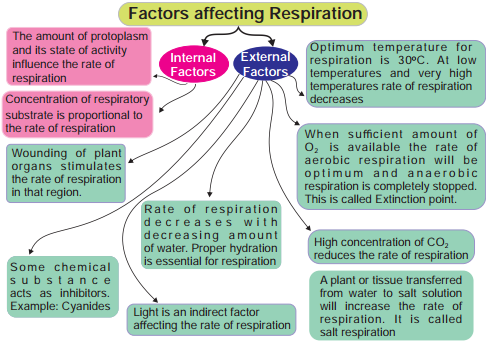Learninsta presents the core concepts of Biology with high-quality research papers and topical review articles.
Factors Affecting Respiration
The eight environmental factors effecting the rate of respiration are:
- Oxygen Content of the Atmosphere
- Effect of Temperature
- Effect of Light
- Effect of Water Contents
- Effect of Respirable Material
- Effect of Carbon Dioxide Concentration
- Protoplasmic Conditions and
- Other Factors
The process of respiration is influenced by a number of external and internal factors. The main external factors are temperature, light, oxygen supply, water supply, CO2 concentration, toxic and stimulating substances and disease and injury.
For most plant species temperature, acidity, salt concentration and the amount of moisture, carbon dioxide and oxygen are some of the additional important factors which affect respiration. Let’s see the factors affecting the rate of respiration.
Temperature:
At a very high temperature, the rate of respiration decreases with time, and at very low temperature, the respiration rate is insignificant.
Carbon Dioxide Concentration:
The higher the carbon dioxide concentration, the lower the rate of respiration.
Explanation:
The rate of breathing is affected by many chemical factors like the level of carbon dioxide and oxygen in the blood. The increase in levels of the carbon dioxide will lower the blood pH this will direct the medulla of the brain to increase the breathing rate to obtain more amount of oxygen in the body.
Brainstem Rhythmicity Center. Breathing usually takes place outside of your conscious awareness. Blood Carbon Dioxide. The amount of carbon dioxide in the blood exerts a strong influence on respiratory rate. Blood pH.
The main factors affecting breathing rate are the levels of carbon dioxide and oxygen in the blood, and the blood’s pH. The main factors affecting rate of photosynthesis are light intensity, carbon dioxide concentration and temperature.
Several factors can affect the rate of photosynthesis:
- Light Intensity
- Carbon Dioxide Concentration
- Temperature
Chemical – carbon dioxide, hydrogen ions and oxygen levels are the most important factors that regulate respiration. CO2 levels are the main influence, oxygen levels only affect breathing with dangerously low.
Oxygen, carbondioxide, temperature, light, availability of respirable materials etc., affect the rate of respiration. Oxygen is most important for aerobic respiration.
The temperature, light, materils of respiration such as carbohydrates, fats, proteins, etc., affect the rate of aerobic respiration.
External Factors:
Many external factors like temperature, light, carbon dioxide etc., affect the rate of respiration.
Temperature:
Temperature significantly affects the rate of respiration. Usually, the rate of respiration increases with the increase in temperature in the range of 0-45 degree centigrade.
- Factors that influence blood pressure
- Cardiac output
- Peripheral vascular resistance
- Volume of circulating blood
- Viscosity of blood
- Elasticity of vessels walls
The factors that affects temperature are altitude, latitude and distance from sea. The height measured from sea level is called altitude. When the latitude increases, the distant from the sun also increases, so the temperature gradually decreases. When the altitude increases, the temperature also gradually decreases.
The rate of respiration is normally not affected by increase of carbon dioxide concentration in the surrounding atmosphere up to 19%, but as the concentration increases from 10% to 80%, a progressive decrease in respiration occurs.
Normally, an increased concentration of carbon dioxide is the strongest stimulus to breathe more deeply and more frequently. Conversely, when the carbon dioxide concentration in the blood is low, the brain decreases the frequency and depth of breaths.
The external or environmental factors at: A light intensity, carbon dioxide concentration and temperature. The internal factor influencing the photosynthesis is chlorophyll content of the leaves and protoplasmic factors.
The environmental factors which can affect the rate of photosynthesis are carbon dioxide, light, temperature, water, oxygen, minerals, pollutants and inhibitors.
1. Effect of Carbon Dioxide:
Being one of the raw materials, carbon dioxide concentration has great effect on the rate of photosynthesis.
